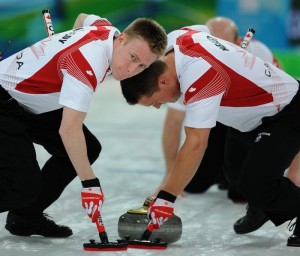Hey Coach: The Last Straw – sweeping fabrics and how they can improve your game!
This blog was created by Scott Arnold who worked hand in hand with the University of Western Ontario when they were working on sweeping technique and fabric identification on behalf of the CCA and Own The Podium. Please read the information Scott has provided to you – this has the ability to seriously help your game – both in the club and on the bonspiel trail. It may be time to trade in your old hair broom!!
Thanks again Scott! Here we go:
The Last Straw
Curling brooms generate heat from friction using a combination of downward pressure and side to side motion. The proper technique to maximize this effect has been discussed in a previous post (https://www.curling.ca/2010/10/24/hey-coach-sweeping-part-two/). During the Own the Podium Top Secret Sweeping Study, the scientists asked our athletes to throw whatever type of broom they wanted into the testing laboratory. They tested current brooms, ones that hadn’t been seen in years and some that were not commercially available. They tested synthetic and hair. This post will share the findings and hopefully help everyone interested become better sweepers by using the best equipment available. Let us first look at synthetic heads.
It is absolutely essential that a broom head must be clean. Any dirt that lies between the fabric fiber impedes the fabrics friction which in-turn decreases the heat generated. Broom heads must also be dry. It was found that wet broom heads lose effectiveness as much as dirty broom heads. Our top teams on tour will change their broom heads 2-4 times per game. Club curlers should know that they need to purchase a couple of replacement broom heads each season. After a game or two, take off one head and replace it with the other. Take the used head home and clean it with a scrub brush, soap and water. Rinse thoroughly. Let it air dry for a couple of days and it will be ready to be rotated with the head on the broom.
Stencilling could do the same thing as dirt. Preliminary research suggests stencilling that sits above the fabric may decrease the effectiveness of the broom head. Some types of stencilling use an ink that is “absorbed” by the fabric. This type of stencilling may not negatively effect the performance of the head as much. More research is required in this area.
The depth of foam on a synthetic head also has an impact on effectiveness. The scientists believe a small amount of foam is necessary to allow the head to get into the pebble to heat the ice. Too little foam and the head stays on top of the pebble and does not generate as much friction heat. Too much foam absorbs the downward pressure from the sweeper and lessens the friction necessary to heat the ice.
A plethora of fabric types and colours were tested. There was no data to confirm one colour was more effective than another. That means skips/thirds should keep using brush heads that are easy to see as a target from the other end and front end players can keep using their favourite colour. The vast majority of fabrics tested on commercially available replacement broom heads were very effective. The study did test some “third party” broom heads from smaller, lesser known manufacturers. Although some tested well, others were less effective while some were actually damaging the ice surface. That is the last thing you want to do while sweeping. Replacement synthetic broom heads that have the look and feel of an original broom’s head are your best bet.
Hair brooms are excellent at getting into the pebble and removing/melting frost. In fact, they are the preferred type of broom for frosty conditions. Unfortunately, the study found they are never as effective as synthetic broom heads at heating the ice. If you are using a hair broom in combination with a synthetic broom, it would be advisable to have the hair broom furthest away from the stone to remove any frost and to start the heating process for the more effective synthetic broom closer to the stone.
Like their synthetic counterparts, hair brooms need to be cleaned regularly and replaced. Rubbing your hand over the broom head to dislodge any loose hairs and debris is necessary before every game (and should be done away from the ice surface). Hair brooms lose their effectiveness when wet so that should be monitored as well. Being a natural product, hair will break over time. If you do use a hair head, you should start each season with a new one and consider replacing it during the season if it looks to be breaking down.
Own the Podium’s Top Secret Sweeping Study gave us many answers to sweeping questions we have pondered as curlers for many years. It also raised a number of questions that we hope to answer in preparation for Socchi in 2014.





